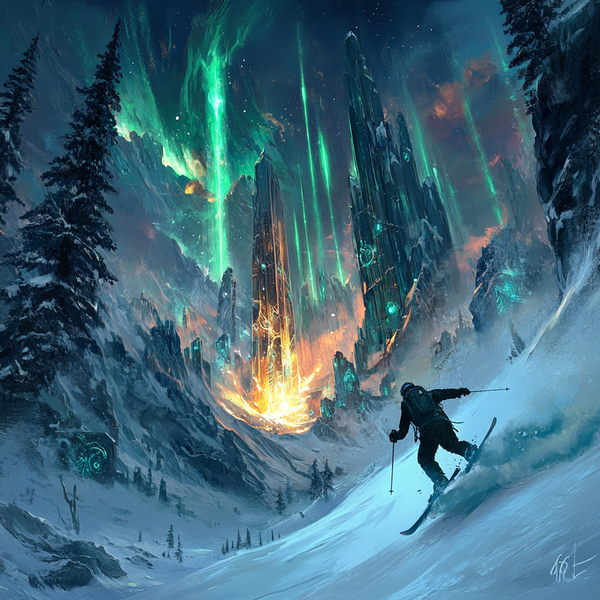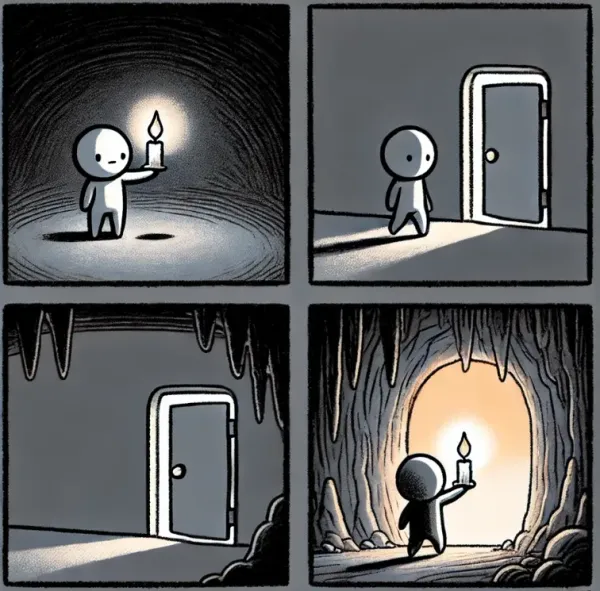The Bridge Back to Magic
Six transformational insights

[12 minute read/ 8 minute listen]
Knowledge leads to power. Knowledge is learning how the world really works, power comes from having the courage to live in alignment with that knowledge.
There’s a 100 foot chasm between our current failing worldview and the more accurate one we all need to reach. As a self-described “curiosity Sherpa,” my goal in life is to build a 95 foot bridge.
Some of the most valuable information you can consume is whatever takes you across this bridge and makes the eventual leap of faith less daunting.
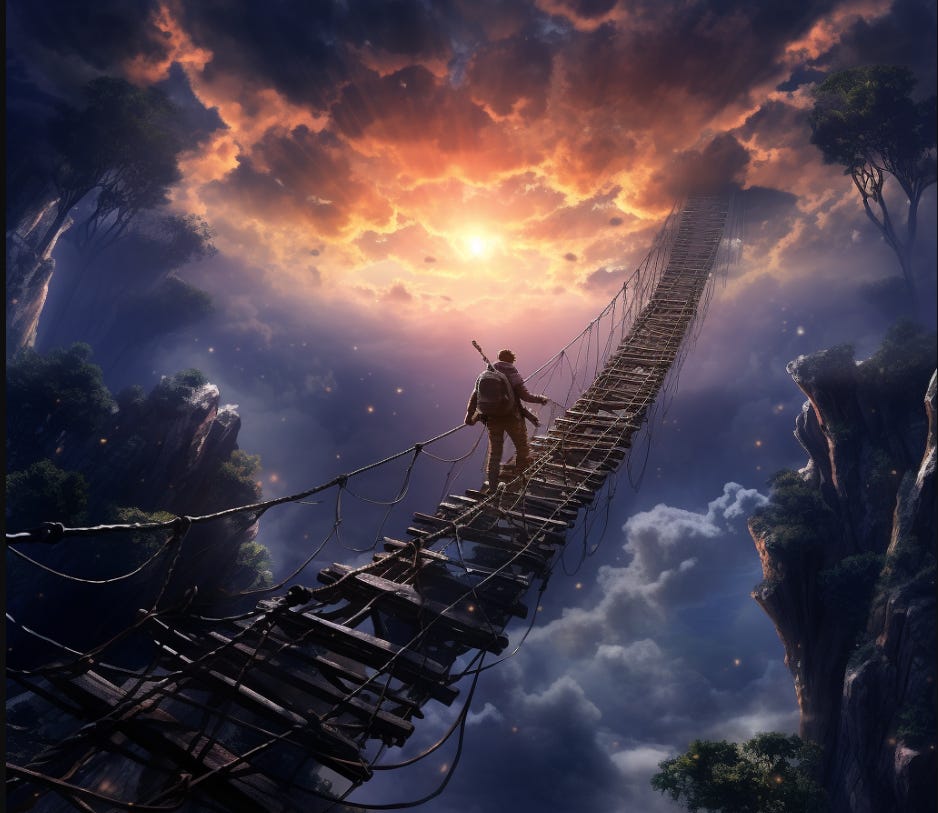
The “95 Foot Bridge”
Back in 2017, I had an experience that obliterated my rational worldview. Everything I thought I knew about the nature of time and consciousness was immediately undermined by a direct experience that felt “more real than real.” I was plunged into psychological chaos for a long time. It has taken me six years of obsessive work since to build a bridge back to the experience that explains it in satisfactorily scientific terms.
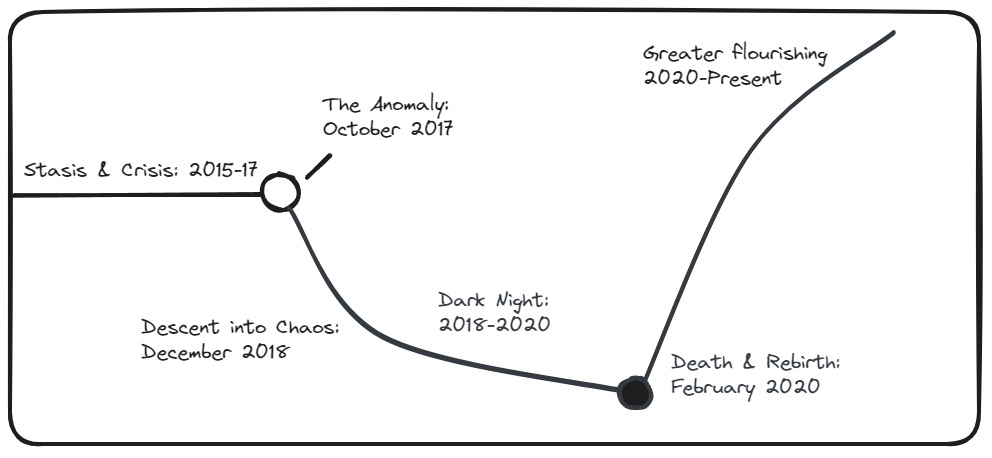
My own intellectual progression across the bridge has obviously been personal, but perhaps it’s helpful to others. I found six foundational pillars in the following order (the footnotes go to the key articles and books):
Mythology (Joseph Campbell). Myths aren’t fantasies, they reflect underlying deep realities of evolutionary importance. The most ubiquitous story is the Hero’s Journey, because it describes the transitional process of harmonizing with hidden forces that direct your growth.1
Psychology (Carl Jung). There are unconscious forces much larger than our ego guiding our evolution, and one way they do so is by directing our attention in the present.2
Neurology (Iain McGilchrist). His meticulously researched neurological theories were the real turning point for me. He argues that an imbalance towards our brain’s more vocal left hemisphere explains why we often cannot conceive of these guiding forces and defensively deny their existence. The largely mute right hemisphere is more aligned with these external forces, and directs your exploratory attention.3
Taoism. There is a deeper reality, a flow, you can harmonize with, and your life goes great if you do. The ideal state is an “effortless action” where your narrow will surrenders to these broader forces that work through you.4
Complexity theory. The direction of the universe trends towards greater complexity. Complexity means each of us becoming both more differentiated and more integrated into the whole. There is an emergent force pulling you in this direction, and one way it manifests is through your curiosity; what feels meaningful and what gives you energy.5
Quantum physics. One interpretation is that the future exists suspended in quantum potential. We are drawn towards an optimal version of that future, towards coherence and complexity, by what Ervin Laszlo calls the “holotropic attractor.”6
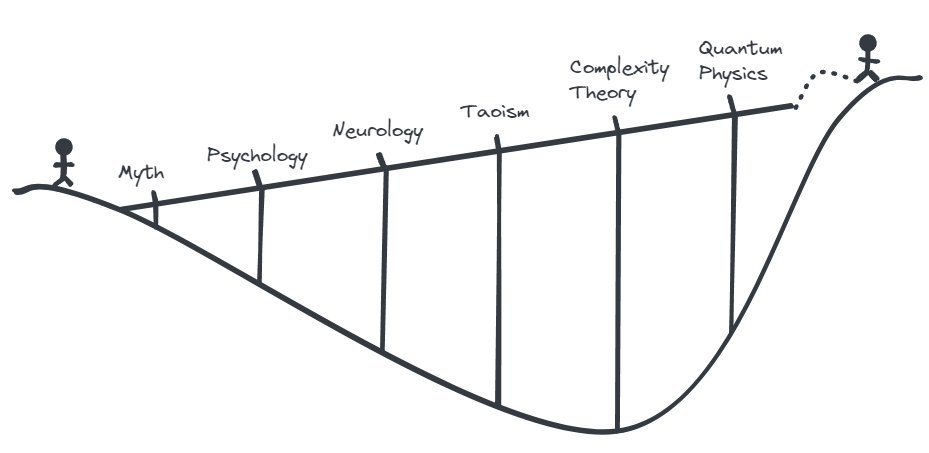
As you can see, all these theories lead to very similar conclusions, but from dramatically different starting points. That’s the kind of “consilience” I spend my life searching for. I’ve had to discard a mountain of bad scientific ideas and spiritual literature to isolate a small number of theories that seem to ring true. They all point towards the existence of a greater force we can harmonize with.
But there’s a world of difference between knowing something is true and acting as if it’s true. This is jumping the last five feet.
The Leap of Faith
"The only thing anyone needs to be special is to believe that you can be. I know that sounds like a cat poster, but it's true.”
-Vitruvius, The Lego Movie.
The leap of faith is a standard climax of contemporary Hero’s Journey stories (spoiler alert!). Neo “frees his mind” to jump between buildings in The Matrix. Luke Skywalker switches off his targeting computer to blow up the Death Star in Star Wars. Miles Morales springs off the skyscraper in Across the Spider-Verse (my favourite 2 minutes of animation ever).
What does it mean?
One of the wildest ideas I’ve ever encountered is that our conscious experience of the world, and our actual abilities, are materially altered by what we believe to be possible.
For example, over the course of this year, I’ve been reluctantly forced to consider that certain kinds of mental abilities I previously regarded as debunked “woo” seem to be scientifically proven.7 These are “psi” phenomena such as telepathy, precognition and remote viewing (mentally identifying objects or places across large distances). For me, the most interesting aspect of this research is that your own psi abilities seem to correlate with your belief that they are possible.8 They may also be trainable. This would obviously make sense: if your own consciousness thinks certain abilities are impossible, it’s not even going to try. This is why psi seems to be more prevalent in children, who have no preconceived notion of what their consciousness can do.
But many spiritual traditions stress that these “superpowers” are distractions from the main event. The true goal is the reunion of our advanced individual intellect with the wisdom of this guiding intelligence. Believing this force even exists is obviously the first step. But it isn’t a “propositional” belief, in a bunch of abstract facts, it’s a participatory one. Knowledge that the universe rewards both your differentiation and integration then requires that you actually act that way.
As an illustration, when I had an abstract understanding of the leap of faith concept, I left three jobs in succession without a backup plan, in escalating states of desperation. The first time I quit, I passively sat on the couch waiting for “the universe” to send me a sign. I was sure it would protect me from falling into the darkness. It decidedly did not. This was because I was not actively manifesting my individual skills in an integrated way. It was only when I started publicly exploring my strange mix of finance and meaning, a win-win creation, that the world has responded so positively. I then received direct feedback, and it has produced material and spiritual abundance in my life. Faith means first believing you have a gift and then cultivating it, then offering it to the world. This is difficult.
The central problem is that you probably can’t know what the world needs you to do until it tells you. And it can’t tell you until you’ve offered it something of value first. This is what a sacrifice is. And it’s rarely trivial, especially when you have a family to support. Does this mean quitting your job? Does it mean moving cities? Does it mean creating something that scares you? It’s so hard to know, and there’s often so much at stake. Everyone’s gifts are different, but the only consistent truth is that it seems to require some kind of considered leap, an “active surrender,” into the murky unknown.
You can start to participate in the belief by following your curiosity. Through cultivating your intuition and discernment you can get more accurate feedback from the world. But you first need to believe synchronicities are real, before you can allow the coincidences to guide you.
The “One-Inch-Punch”
“If we are not aware, systems try to lead us. The more we are aware, the more we can dance with them."
-Jan Jacob Stam
The most optimistic interpretation of the post-Enlightenment descent into a disenchanted world is that it has given us extraordinary powers of scientific analysis. Instead of the nihilistic conclusion that we’re inevitably doomed to destroy the world, thinkers like Bernardo Kastrup9 and Richard Tarnas10 have made persuasive arguments that this was a necessary, if tragic, stage in our collective journey.
Perhaps we lost our gifts for a good reason. We had them as more primitive “kids” then lost them as spiritually-immature adolescents. I am pretty sure I know how I would have used remote viewing skills as a pubescent fourteen year old. Millennia of human myths have consistently warned us that using these innate gifts in narrow service of power invites unexpected catastrophe. Be careful what you wish for and what you manifest. We needed to be initiated into our powers. This challenging process is what our culture is currently experiencing.
There are many people that believe the future reunion of our powerful, analytical minds with a guiding intelligence represents an entirely new stage of human evolution. It’s a romantic idea, although it definitely has an elitist edge to it. Either way, it’s definitely true that this path is open to everyone, right now. [I recently outlined what I see as the practical applications of these ideas on the Barrons Advisor podcast, below].
What might this next stage look like? It looks a lot like wisdom. It means becoming increasingly sensitive to subtle external signals, but with the inner discernment to know exactly what’s relevant. Power that looks effortless. There’s a legendary martial arts technique called the “one-inch-punch.” The master is able to generate massive force from a tiny distance with almost imperceptible movement. They act decisively, in total inner and outer harmony.
Can we dream beyond that? Science is increasingly confirming the spiritual belief that trained, focused attention can influence reality in ways we previously dismissed as “magical.” When deployed in harmony with the world, it’s a thrilling idea. We are gaining an increasingly accurate understanding of subtle forces we can work with to make everything better. If they are indeed a reality, the party tricks of psi would undoubtedly be cool. But the real superpower is living a life where what’s blissful for you and beneficial for the world gradually becomes the same thing.
“The mystery of life isn't a problem to solve, but a reality to experience. A process that cannot be understood by stopping it. We must move with the flow of the process. We must join it. We must flow with it.”
- Jamis, Dune
Related Reading & Listening
- Listen. What Is Your Curiosity Calling You to Do? My interview with Steve Sanduski on the Barrons Advisor podcast (52 minute listen).
- Why listen. Steve was a brilliant interviewer who kept wrestling me back to both practical applications of my theories and their relevance to wealth management.
Read/listen. Daniel Ingram on Emergent Phenomena, an interview with (63 minute read)
Why read/listen. If you’re on a more overtly spiritual/meditation track this interview is fascinating. Ingram has a robust scientific background but also seems to have a deep understanding of spiritual practices and their neglected pitfalls. His comments on the pathologisation of spiritual states are both generally urgent and specifically relevant to my own story. If you go into these practices at the wrong end of the 100 foot bridge, you can fall into chaos rapidly and unexpectedly.
But the mindfulness movement made something of a grand bargain. Early on, it wasn't quite so clear what the bargain was. But it was recognized that it would succeed in the clinical mainstream by sticking very much to the shallow end - this is going to reduce anxiety and depression, this is going to help people deal with trauma.
It's not that that this wasn't described in the old texts, it is. But the other side was the big prize. That would have been seen as the small prize in comparison to the big prize of awakening. That was the reason for founding a 2500-year lived religion that spread across Southeast Asia and around the world. And so modern mindfulness cut off not only the benefits, but also the known challenges and the weird stuff. These practices were known to lead to powers - seeing beings and weird energetic stuff and lots of strange things that makes the people who want to scale this stuff clinically very nervous, because they know the clinical mainstream is not very ready for that. [Emphasis added].
Listen. Animism is Normative Consciousness by The Emerald (1 hour 2 minute listen)
Why listen. All that slightly intimidating title means is that, when it comes to seeing the natural world as magical, we are the disenchanted weirdos in the West.
But here's the heart of it. When modern Western science encountered animism absolutely everywhere, they assumed that its prevalence said something about the people in question. They never paused to consider that the fact that they were the only ones who did not see the world in this way said more about them than about the 99% of people who did. The fact is the 99% were normative. They were not because animism is normative consciousness.
For those of you following my Melodic EDM obsession, this recent Parra for Cuva set is incredible, especially to work to.
The information provided is for educational and informational purposes only and does not constitute investment advice and it should not be relied on as such. It should not be considered a solicitation to buy or an offer to sell a security. It does not take into account any investor’s particular investment objectives, strategies, tax status or investment horizon. You should consult your attorney or tax advisor.
The views expressed in this commentary are subject to change based on market and other conditions. These documents may contain certain statements that may be deemed forward looking statements. Please note that any such statements are not guarantees of any future performance and actual results or developments may differ materially from those projected. Any projections, market outlooks, or estimates are based upon certain assumptions and should not be construed as indicative of actual events that will occur.
I found The Hero With A Thousand Faces unreadable, even after two attempts. However The Power of Myth is magical. Ashwin Sharma shared arguably the most important moment in the whole series last week; Joseph Campbell on the leap of faith. ↩
Jordan' Peterson’s Jacob’s Ladder lecture on this topic is probably the most interesting single podcast I’ve ever heard. ↩
This interview in Beshara Magazine about his masterpiece The Matter With Things is the best thing I’ve read that isn’t the book itself, and it’s my favourite book. ↩
I found the original texts initially difficult to get into. But Ed Slingerland’s book Trying Not to Try was the turning point for me. His podcast with Jim O’Shaughnessy on Infinite Loops is a great intro. ↩
My overly-ambitious shot at making this argument in less than ten minutes is here. ↩
Dr. Mona Sobhani’s excellent book Proof of Spiritual Phenomena was my gateway drug and is an excellent starting point. Mona recently did a great podcast with my friend Camellia Yang that discusses this in detail. ↩
Source: Real Magic: Ancient Wisdom, Modern Science, and a Guide to the Secret Power of the Universe by Dean I. Radin. “The results of this meta-analysis are quite clear—if you believe in the paranormal you will score higher on average in forced choice ESP tests than someone who does not [believe].”- believers outperformed disbelievers with odds against chance of over a trillion to one, via psychologist Tony Lawrence ↩
I’ve been thinking about this article by Kastrup for weeks. The destiny of Western culture: An open letter to Peter Kingsley. “Only direct experience is transformative. However, given the mindset of Western culture, one must first give oneself intellectual permission to have the experience, to be rationally open to it, in order to have any chance of experiencing it.” ↩
“The driving impulse of the West's masculine consciousness has been its dialectical quest not only to realize itself, to forge its own autonomy, but also, finally, to recover its connection with the whole, to come to terms with the great feminine principle in life: to differentiate itself from but then rediscover and reunite with the feminine, with the mystery of life, of nature, of soul… The telos, the inner direction and goal, of the Western mind has been to reconnect with the cosmos in a mature participation mystique, to surrender itself freely and consciously in the embrace of a larger unity that preserves human autonomy while also transcending human alienation.”- Tarnas in the epilogue of The Passion of the Western Mind, the last 4 pages are dynamite. ↩

